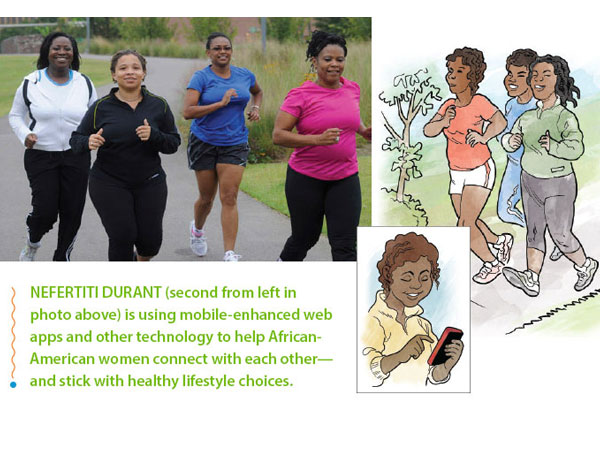Social Networking for Behavior Change
Nefertiti Durant, M.D., wanted to know how the Internet could help young African-American women lose weight. To find out, the UAB adolescent medicine physician is taking an approach straight out of Silicon Valley: crowdsourcing.
In a series of studies, Durant is refining a Web-based, culturally relevant tool to help participants African-American women ages 19 to 30 stick with a moderate walking program. Her site lets participants track their diets and physical activity, find healthy recipes, and discuss their successes and setbacks on message boards.
“We had very good findings in phase 1,” says Durant. “We showed an increase in moderate physical activity of 81 minutes,” along with an increase in HDL, the “good” cholesterol. The biggest problem was “keeping the young women in the study,” Durant says. Almost half of the original participants dropped out during the six-month project. “But of those who did stay in, 85 percent enjoyed the tool and the program in general.”
Styles Matter
Durant set about revamping the project for a second phase, using her original participants as a focus group. Hair turned out to be a major exercise obstacle for the young women, Durant says. The sweat from a workout can quickly destroy a salon-fresh style, especially chemical-intensive “relaxed” hair. “Everyone wants to look nice, particularly women at this age,” Durant says.
Durant added a blog on haircare advice, including entries on special headbands and shampoos to preserve hairstyles. She also addressed another concern: photos. The original study site featured pictures of trim women exercising. “They wanted to see women of more diverse shapes and hairstyles,” Durant says. “They said, ‘We want to see people like us, not models.’” She scheduled a photoshoot at Birmingham’s Railroad Park and added images of a wide range of women working out. She also optimized the site for viewing on smartphones a must-have feature for this age group, Durant says.
Preliminary data indicates the changes made a big difference. “We again saw a significant increase in moderate physical activity, but this time we had 80 percent retention,” Durant says. “We also saw increases in participants’ reported social support.”
The participants were outspoken in support of Durant’s requirement that they connect by blogging and posting messages about their experiences. “They had formed real bonds,” Durant says. “Some posted messages several times a day. They would write some very touching things. It was a safe space to tell their story with people who understand.”
Tell It Like It Is
 In a new project, tentatively titled Fit Heart Narratives, Durant is exploring the power of storytelling as a motivational tool. She plans to create a series of videos in which participants tell their stories of battling obesity.
In a new project, tentatively titled Fit Heart Narratives, Durant is exploring the power of storytelling as a motivational tool. She plans to create a series of videos in which participants tell their stories of battling obesity.
The idea builds on a successful project led by former UAB faculty member Jeroan Allison, M.D., who filmed patients with hypertension talking about their successes and failures in keeping their blood pressure under control. Patients who saw the videos in addition to their usual doctor’s visit had better outcomes than those who spoke to a doctor alone, Durant says. The concept is now being adopted nationwide.
“People always talk about the successes,” Durant says. “That’s what you hear in the weight-loss ads on TV. But our participants have said, ‘We want to hear the beginning, the middle, and the end. We want to hear it all, not just the good stuff. We want to know how you overcame the struggles.”
Text This, Not That
One of Durant’s colleagues in the Department of Preventive Medicine, Jasmine Pagan, M.D., is studying text messaging as a motivational tool. Several women in Durant’s original study agreed to brainstorm texts that could help peers push through obstacles to working out. “They each wrote the messages they would like to hear,” Durant says. “Then my staff texted them out over a couple of weeks, and the girls re-rated them.” After several iterations, “we now have a bank of messages that address shame, hair problems, feeling like you don’t have enough time to work out, and more,” Durant says. She and Pagan plan to keep the writing and review process going with future groups.
Durant hopes to combine all of these insights into a single study in a large population. Her goal is to create a research-tested tool she can use in her own practice to connect with patients and connect them with each other. “They know what they need to do,” she says. “We just have to find a way to nudge them.”